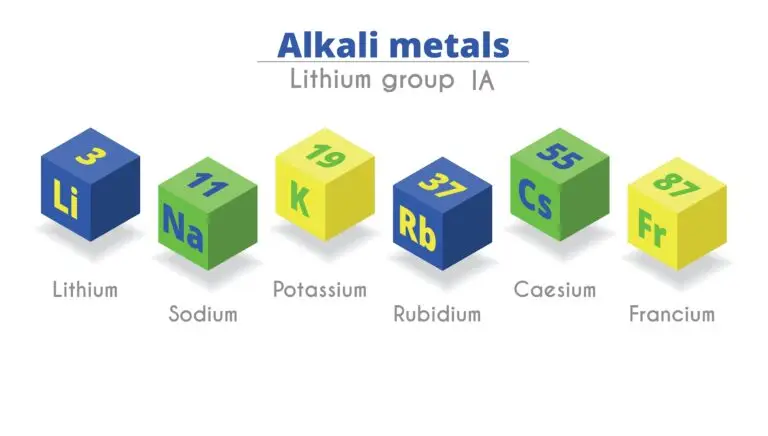Alkali Metals

Table of Contents
What are Alkali Metals?
Alkali metals are chemical elements found in Group 1 of the periodic table. These elements include lithium (Li), sodium (Na), potassium (K), rubidium (Rb), cesium (Cs), and francium (Fr).
These elements are highly reactive metals that readily lose their outermost electron to form a singly charged positive ion (cation) when they react with other substances. They are typically soft, silvery-white metals with low melting points and densities. Alkali metals are known for their vigorous reactions with water, producing hydrogen gas and forming alkaline solutions (hence the name “alkali metals”).
Alkali Metal Properties
Reactivity
The reactivity of alkali metals, such as lithium, sodium, potassium, rubidium, cesium, and francium, is a distinctive characteristic attributed to their electronic configuration. These metals possess a single valence electron in their outermost shell, making them highly reactive.
The reactivity increases down the group, with francium being the most reactive alkali metal. This reactivity is due to the ease with which alkali metals can lose their outer electron to form positively charged ions, known as cations. This process, called ionization or oxidation, forms stable ions with a noble gas electron configuration, which is energetically favorable.
When alkali metals react with other elements or compounds, they often exhibit vigorous reactions, such as rapidly producing heat, light, and hydrogen gas. For example, when sodium metal is added to water, it reacts exothermically, releasing hydrogen gas and forming sodium hydroxide. This reaction is highly exothermic and can be explosive in the case of alkali metals like potassium and cesium.
The reactivity of alkali metals finds widespread applications in various industries, such as in the production of batteries, alloys, and chemical synthesis processes where their ability to donate electrons readily is utilized for specific reactions.
Softness
Alkali metals are super soft because of how their atoms are arranged and stick together. They have just one electron on the outside, weakening their bonds. This means their atoms can easily move around and slide past each other.
Even the heaviest alkali metals like cesium and francium are super soft because they are big and have many electrons shielding them. This softness makes them easy to shape and bend without much force.
We use these metals in different ways, like using liquid potassium and sodium to cool down things in nuclear reactors or mixing lithium with other materials to make lightweight stuff for planes and cars. But because they’re so soft, they also react quickly with air and water, so we have to handle them carefully and store them properly to keep them from getting damaged.
Low Melting and Boiling Points
Alkali metals have low melting and boiling points, which means they can turn from solid to liquid to gas at relatively low temperatures compared to other metals. This happens because alkali metals have weak forces holding their atoms together. When we heat them, these forces break easily, causing the metal to melt and eventually boil into a gas.
For example, sodium, a common alkali metal, melts at just 98 degrees Celsius (about 208 degrees Fahrenheit) and boils at 883 degrees Celsius (about 1621 degrees Fahrenheit). Because of their low melting and boiling points, alkali metals are often used in fireworks to create colorful flames when they burn or in alloys to make lighter and more heat-resistant materials.
Electrical Conductivity
Alkali metals are good conductors of electricity because of their unique atomic structure. They have one electron in their outermost shell that is loosely held, making it easy for this electron to move around.
When a voltage is applied, these electrons can flow through the metal, carrying an electric current. This property of conducting electricity is essential for many applications, such as wires for transmitting electricity, batteries for storing energy, and electronic devices like phones and computers.
However, alkali metals can react with moisture in the air, so they are often used in sealed environments or coated to prevent corrosion while maintaining their excellent electrical conductivity.
Flame Test
The flame test for alkali metals is a simple but fascinating way to identify them based on the colors they produce when heated in a flame. Each alkali metal, like sodium, potassium, or lithium, gives off a unique color when burned.
For example, sodium makes a bright yellow color, while potassium gives a purplish hue. This happens because when the metal is heated, its electrons absorb energy and jump to higher energy levels. When they fall back down, they release this energy as light, and each metal emits a specific color based on how much energy is released.
Scientists and chemists use the flame test to quickly identify which alkali metal they’re working with, as each color is like a signature that tells them which element is present.
Reactivity with Water
Alkali metals, like sodium and potassium, react strongly with water. When a small piece of alkali metal is dropped into water, it starts fizzing and releasing hydrogen gas.
This reaction happens because the metal wants to get rid of its outermost electron to become stable, and water helps it do that. As the metal gives away its electron, it forms a hydroxide compound and releases hydrogen gas, which you can see as bubbles.
This energetic reaction can produce enough heat to ignite the hydrogen gas, creating a small flame. Because of their reactivity with water, alkali metals are stored in oil or other substances that keep them from moisture in the air.
Applications & Uses
Alkali metals have various applications in industry and research. Sodium and potassium are essential for biological functions in living organisms. Potassium compounds are used in fertilizers, while sodium compounds are used in soap production and water treatment. Due to its high energy density, lithium is used in batteries, especially rechargeable lithium-ion batteries.
Related Links
Alkaline Earth Metals
The Periodic Table
Atomic Number
Element Groups